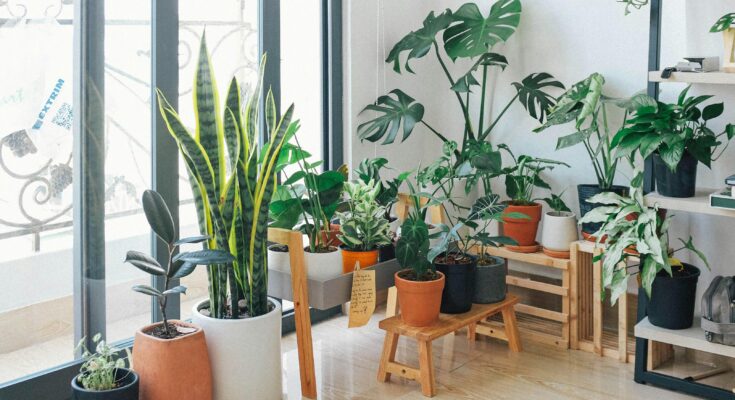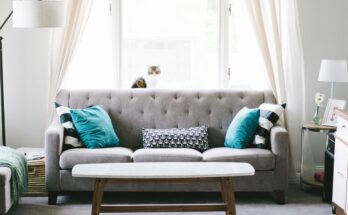Does your place feel a bit too boxed-in or sterile? If so, you’re definitely not the only one. With our busy, tech-filled lives, many of us really want to feel a closer connection to nature, even when we’re inside our homes. That’s where the idea of biophilic design comes into play.
This isn’t just about tossing a few houseplants around. It’s a whole approach to designing your space that brings natural elements into your home in thoughtful ways. This could really help your well-being, lower your stress levels, and turn your space into a more peaceful retreat. The good news is you don’t need to completely remodel your home to make it happen.
Here I share 10 easy and practical ways to bring a bit of the outdoors into your home and create a biophilic design for your home. With these changes, you can create a relaxing indoor escape that feels much more alive and calming. No matter if you’re stuck in a noisy city apartment or enjoying your cozy suburban house, these ideas are perfect for making your space a little more nature-friendly.
1. Let the Sunshine In:
Nothing beats the feeling of sunlight brightening up a room. Natural light can really change the vibe of your space—it’s great for lifting your mood and can even make your rooms feel larger.
Start by taking down heavy drapes and switching to light, airy curtains. If you’re worried about privacy, consider getting blinds that you can adjust. Another trick is to place mirrors across from windows to reflect that lovely light into darker spots. If your home’s a bit short on natural light, try using full-spectrum LED bulbs to mimic daylight. This can help reduce eye strain and make your place feel more inviting.
2. Add Some Houseplants:
Bringing in plants is one of the simplest ways to make your home feel more connected to nature. They not only look nice, but they can also clean the air, help reduce stress, and even make you more productive.
If you’re new to taking care of plants, start with easy ones like snake plants, pothos, or ZZ plants. You can create a nice look by grouping different plants together at varying heights, which mirrors how plants grow in the wild. For smaller spaces, consider hanging planters or terrariums.
Not too confident in your gardening skills? You can opt for preserved moss walls, high-quality faux plants, or dried flowers to create that natural feel without maintenance.
3. Use Natural Materials:
One big part of biophilic design is using raw, organic materials that appeal to our senses. Swap out synthetic stuff for things like wood, stone, jute, bamboo, or linen in your furniture and decor.
Think about adding a reclaimed wood coffee table, a rattan chair, or a stone vase to draw in a bit of nature. Even little touches, like a woven basket for your throws or a cork board, can bring warmth and coziness to your space.
If you’re on a budget, consider giving old wooden furniture a fresh look with natural stains or adding a sisal rug to your living room. Aim to keep things looking a bit unrefined—after all, nature isn’t perfect, so why should your decor be?
4. Bring in Water Features:
There’s something about the sound of flowing water that just makes you feel more relaxed. While you might not have space for a big indoor fountain, there are smaller ways to include water in your home.
Think about a small tabletop fountain, a little aquarium, or a bowl with floating flowers to create a chill spot. If you’re feeling crafty, you could even set up a wall-mounted water feature that uses a recirculating pump for a unique touch.
No room for those kinds of features? Art that showcases oceans, rivers, or rain can still give your space that same calming vibe.
5. Choose Nature-Inspired Colors
Colors can really affect how we feel. Earthy shades—like soft greens, warm browns, blues, and sandy neutrals—are excellent for bringing a touch of nature indoors and creating a calm atmosphere.
You might want to paint an accent wall in a soft sage green or pick out textiles that feature nature-inspired designs, like leafy prints or wave patterns. If you prefer neutrals, think about adding terracotta pots or wooden bowls to keep things aligned with nature.
6. Layer in Scents from Nature:
The scents around us have a big impact on our memories and emotions. Smelling pine might take you to a forest, while citrus scents can remind you of sunny days. In biophilic design, using natural scents is a big part of setting a soothing atmosphere.
Here’s how to do it:
– Essential Oil Diffusers: Go for earthy smelly oils like cedarwood or sandalwood for a grounding feel, or use fresh scents like peppermint for an invigorating boost. You can place diffusers in spots like the entryway or near your workspace.
– Simmer Pots: An easy hack is to simmer citrus peels and spices like cinnamon or herbs on the stove for a comforting scent throughout your home.
– Fresh Herbs: Growing herbs like basil or mint on your windowsill can add a fresh aroma while you’re cooking.
– Beeswax Candles: These are great because they purify the air and give off a subtle, pleasant scent—much better than many synthetic options.
A useful tip: Stay away from synthetic air fresheners since they can trigger headaches and tend to smell artificial. Try dried lavender sachets or a bunch of eucalyptus in your shower for a mini-spa experience.
7. Go for Soft, Organic Shapes:
Nature is all about curves and organic shapes—think of rolling hills, round stones, or swaying branches. So why should your home be full of sharp corners? Biophilic design loves gentle, flowing forms that make spaces feel more welcoming.
Here are some suggestions:
– Furniture Choices: Instead of sharp-edged tables, pick oval or live-edge wooden ones. A curved sofa or a unique-shaped sectional can soften your room’s look.
– Decor Accents: Search for vases that aren’t perfectly symmetrical, rattan lights, or abstract art that reflects natural forms like clouds or water.
– Architectural Tweaks: If you’re renovating, think about introducing curved doorways or arches. For renters, peel-and-stick arched mirrors can mimic that effect nicely.
8. Create a Cozy Reading Spot:
Every home could use a little nook where you can relax with a good book. It should be a spot where you can kick back and feel surrounded by nature.
To set this up, think about the location first. A spot by a window, near a balcony, or even a converted closet can work—just throw in a cushion and some string lights! For furniture, you can add a comfy armchair or even a hanging chair for a fun twist. A little side table made from reclaimed wood can complete your setup nicely.
Make it inviting by layering in a soft blanket and adding rugs made of sheepskin or jute. Don’t forget to add a plant nearby, like a fiddle-leaf fig or air plants in terrariums. Bonus touches could include a small fountain for some soothing water sounds or a nice lamp with warm lighting to make it feel cozy.
9. Keep Fresh Air Flowing:
Stale air can make your home feel tired and lifeless, so it’s important to let in fresh air too. Biophilic design isn’t just about sight; it’s also about breathing in that fresh air.
Here’s how to improve airflow:
– Cross-Ventilation: Open windows on different sides of your home to get a nice breeze going. Even setting them open for just a short while each day can make a difference.
– Air-Purifying Plants: Plants like spider plants or peace lilies can clean the air and add moisture back into it.
– Boosting Natural Ventilation: Use ceiling fans on low speed in summer, or put up a bird feeder outside to invite some chirping friends in.
If you live in a city with lots of pollution, you can make a simple DIY air filter. Just set a box fan by a window while attaching a good filter to it and let it help clean the air.
10. Showcase Your Treasures from Nature:
Your home should tell your unique story, and one of the best ways to do that is by displaying things you’ve collected from nature.
Here are some ideas:
– Shadowbox Displays: Frame interesting finds like seashells, dried flowers, or cool leaves you picked up on walks.
– Floating Shelves: Arrange colorful rocks, pinecones, or geodes along with your books on some stylish shelves.
– Functional Decor: Pieces of driftwood can make perfect towel racks or coasters can be flat stones that remind you of your adventures.
These personal touches not only bring character to your home but also spark memories of past experiences, like a family trip or a hike. And the best part? These treasures usually cost nothing!
Pro Tip: To keep your displays looking coordinated, stick to soft colors like whites and greens when arranging your lovely collection!




